Values, Beliefs, and Culture in Early Childhood Learning Communities
VerifiedAdded on 2022/10/01
|11
|3470
|373
Essay
AI Summary
This essay examines and contrasts the Pasifika and Reggio Emilia approaches to early childhood education, focusing on how values, beliefs, and cultural contexts uniquely shape these learning communities. It explores the historical roots of Pasifika education, emphasizing the role of Pasifika women in establishing early childhood settings that prioritize cultural heritage and community values. The essay highlights the importance of family involvement, language, and multi-ethnic environments in Pasifika settings. In contrast, it delves into the Reggio Emilia approach, which emphasizes science-rich, project-based learning, and the development of children's skills and knowledge through exploration and social interaction. The essay discusses the application of Gee's activity triangle to compare the two educational models, evaluating the subject matter, tools, and outcomes of each. It concludes by arguing for the compatibility of the Reggio Emilia approach for Pasifika children, citing its potential to foster skills and knowledge through exemplary science projects and its emphasis on listening to and understanding children's perspectives. The essay underscores the need for effective transitions between early childhood and primary school and highlights the importance of creating supportive learning environments that meet the unique needs of each child.
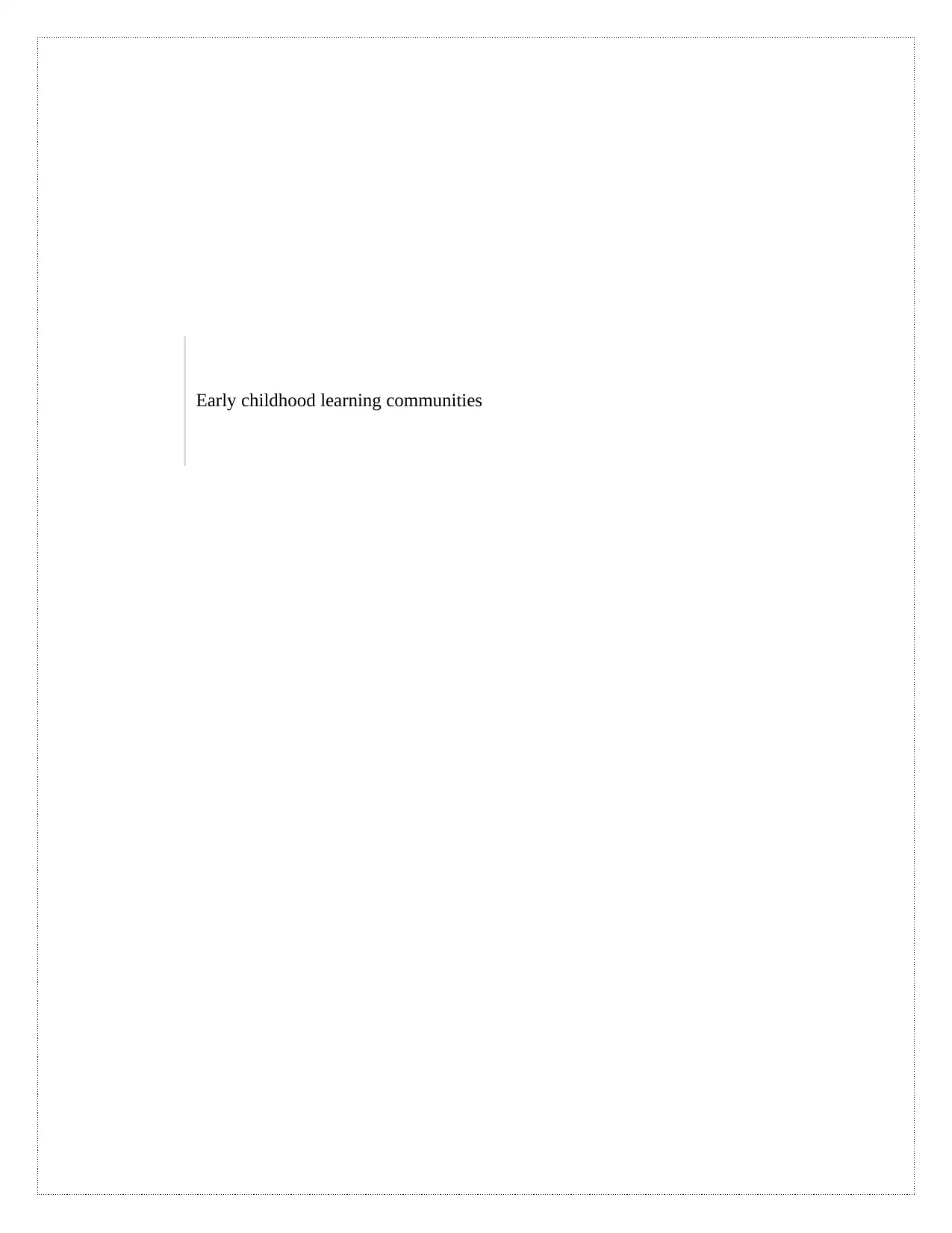
Early childhood learning communities
Paraphrase This Document
Need a fresh take? Get an instant paraphrase of this document with our AI Paraphraser

The right of the children in participating within the educational settings is deemed to be the
universal principle and is stated by many organisations (United Nations Educational, Scientific
Cultural Organization, 1994). The above right becomes compromised when it comes to young
children with special needs or are with disabilities (UN General Assembly, 2007). It is important
that the younger are provided with supports which will ensure their full participation within the
system (Guralnick, M., 2008). While considering the participation of the children WHO
established certain indicators for ensuring the quality provided (World Health Organization,
2007). As of today, education is categorized as the commodity so the associated ideas of ROI
that is the return on investment or the value for money are the seen to have low achievement on
the Pasifika children (Sjöman, M., Granlund, M., and Almqvist, L., 2016). On the other hand, the
Reggio Emilia approach becomes much more compatible when it comes to the standards of
science education in the preschools, since this approach actively helps in creating exemplary
projects of science for developing and nourishing the skills and knowledge in a successful
manner. The aim of the essay is to identify how values, beliefs and cultural contexts uniquely
shape the two communities, i.e., under the Pasifika and the Reggio Emilia approach of early
childhood learning. This essay argues that Reggio Emilia approach can be compatible for the
children, since the creation of exemplary projects will not only develop but will also nourish the
skills and knowledge. For this purpose, the essay will firstly discuss the values, beliefs and
cultural contexts which uniquely shape the two communities by exploring the opportunities for
shared responsibility and agency with the Gee's activity triangle for comparing the two settings
from the purview of the subject, the tools, the outcome, followed by the conclusion.
The Pasifika early childhood education can be traced back to 1970s after the setting up of the
punanga reo that is the playgroup setting in Tokoroa, where the Church offered its hall for
universal principle and is stated by many organisations (United Nations Educational, Scientific
Cultural Organization, 1994). The above right becomes compromised when it comes to young
children with special needs or are with disabilities (UN General Assembly, 2007). It is important
that the younger are provided with supports which will ensure their full participation within the
system (Guralnick, M., 2008). While considering the participation of the children WHO
established certain indicators for ensuring the quality provided (World Health Organization,
2007). As of today, education is categorized as the commodity so the associated ideas of ROI
that is the return on investment or the value for money are the seen to have low achievement on
the Pasifika children (Sjöman, M., Granlund, M., and Almqvist, L., 2016). On the other hand, the
Reggio Emilia approach becomes much more compatible when it comes to the standards of
science education in the preschools, since this approach actively helps in creating exemplary
projects of science for developing and nourishing the skills and knowledge in a successful
manner. The aim of the essay is to identify how values, beliefs and cultural contexts uniquely
shape the two communities, i.e., under the Pasifika and the Reggio Emilia approach of early
childhood learning. This essay argues that Reggio Emilia approach can be compatible for the
children, since the creation of exemplary projects will not only develop but will also nourish the
skills and knowledge. For this purpose, the essay will firstly discuss the values, beliefs and
cultural contexts which uniquely shape the two communities by exploring the opportunities for
shared responsibility and agency with the Gee's activity triangle for comparing the two settings
from the purview of the subject, the tools, the outcome, followed by the conclusion.
The Pasifika early childhood education can be traced back to 1970s after the setting up of the
punanga reo that is the playgroup setting in Tokoroa, where the Church offered its hall for
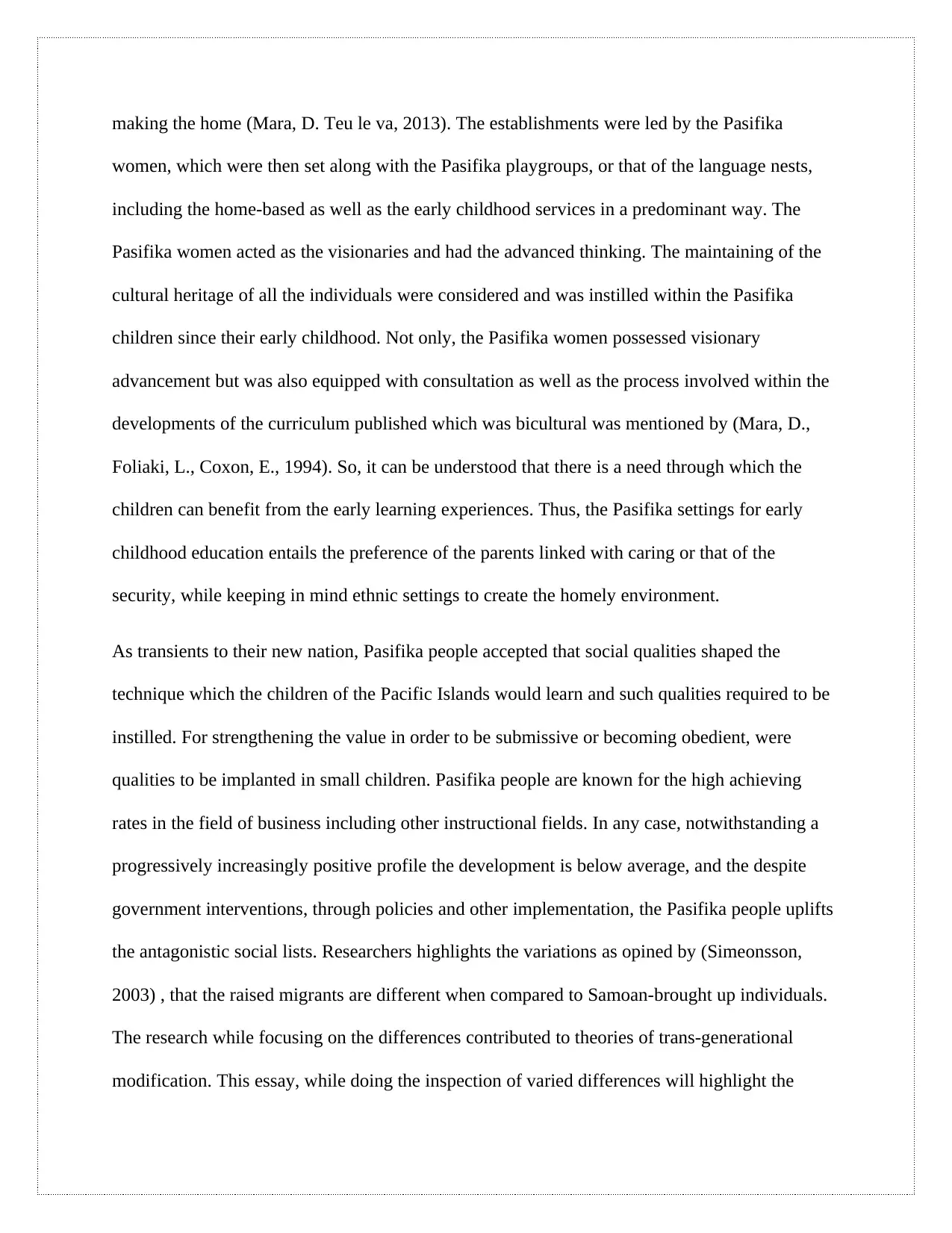
making the home (Mara, D. Teu le va, 2013). The establishments were led by the Pasifika
women, which were then set along with the Pasifika playgroups, or that of the language nests,
including the home-based as well as the early childhood services in a predominant way. The
Pasifika women acted as the visionaries and had the advanced thinking. The maintaining of the
cultural heritage of all the individuals were considered and was instilled within the Pasifika
children since their early childhood. Not only, the Pasifika women possessed visionary
advancement but was also equipped with consultation as well as the process involved within the
developments of the curriculum published which was bicultural was mentioned by (Mara, D.,
Foliaki, L., Coxon, E., 1994). So, it can be understood that there is a need through which the
children can benefit from the early learning experiences. Thus, the Pasifika settings for early
childhood education entails the preference of the parents linked with caring or that of the
security, while keeping in mind ethnic settings to create the homely environment.
As transients to their new nation, Pasifika people accepted that social qualities shaped the
technique which the children of the Pacific Islands would learn and such qualities required to be
instilled. For strengthening the value in order to be submissive or becoming obedient, were
qualities to be implanted in small children. Pasifika people are known for the high achieving
rates in the field of business including other instructional fields. In any case, notwithstanding a
progressively increasingly positive profile the development is below average, and the despite
government interventions, through policies and other implementation, the Pasifika people uplifts
the antagonistic social lists. Researchers highlights the variations as opined by (Simeonsson,
2003) , that the raised migrants are different when compared to Samoan-brought up individuals.
The research while focusing on the differences contributed to theories of trans-generational
modification. This essay, while doing the inspection of varied differences will highlight the
women, which were then set along with the Pasifika playgroups, or that of the language nests,
including the home-based as well as the early childhood services in a predominant way. The
Pasifika women acted as the visionaries and had the advanced thinking. The maintaining of the
cultural heritage of all the individuals were considered and was instilled within the Pasifika
children since their early childhood. Not only, the Pasifika women possessed visionary
advancement but was also equipped with consultation as well as the process involved within the
developments of the curriculum published which was bicultural was mentioned by (Mara, D.,
Foliaki, L., Coxon, E., 1994). So, it can be understood that there is a need through which the
children can benefit from the early learning experiences. Thus, the Pasifika settings for early
childhood education entails the preference of the parents linked with caring or that of the
security, while keeping in mind ethnic settings to create the homely environment.
As transients to their new nation, Pasifika people accepted that social qualities shaped the
technique which the children of the Pacific Islands would learn and such qualities required to be
instilled. For strengthening the value in order to be submissive or becoming obedient, were
qualities to be implanted in small children. Pasifika people are known for the high achieving
rates in the field of business including other instructional fields. In any case, notwithstanding a
progressively increasingly positive profile the development is below average, and the despite
government interventions, through policies and other implementation, the Pasifika people uplifts
the antagonistic social lists. Researchers highlights the variations as opined by (Simeonsson,
2003) , that the raised migrants are different when compared to Samoan-brought up individuals.
The research while focusing on the differences contributed to theories of trans-generational
modification. This essay, while doing the inspection of varied differences will highlight the
⊘ This is a preview!⊘
Do you want full access?
Subscribe today to unlock all pages.

Trusted by 1+ million students worldwide

issues the dynamically constructive profile of Pasifika society with the antagonism identified
within the same Pasifika community. The straightforward absence of investigation and
verification around effective changes for Pasifika students from early childhood education to
primary school, as identified by (Sally Peters- Ministry of Education., 2010). So, there is the
need of the extra investigation for Pasifika children who are transgressing from early childhood
education to primary school.
Most importantly, the need to amass the voices of is for detecting the approach needs to be taken
for lessening the unfavourable conditions. (Keddell, 2005) clarifies the moving out of the
Pasifika children from early stages settings into Palagi schools which precipitates appallingly
limited data around early youth settings. The significance of change to high school from early
childhood education cannot be belittled, so a fruitful change will help in setting the child on an
effective learning for the near future (Sjöman, M., Granlund, M., and Almqvist, L., 2016). So,
the basic demand from the school is to incorporate the right strategy. The impact of the
interconnected variables does create the effective progress, if begun with the initiative in schools
through the progress technique which have the potential to actualize a durable change
satisfactory work force and resourcing so as to ensure that the each and every child gets the
required support on their entry to the school. The child must not be held in disengagement, so the
fundamental duty of the schools is in the creation of a child who will be the true learner. Thus,
the Pasifika education setting lays the emphasis on the significance of character, followed by the
difference in language with the multi- ethnic culture amongst the families and networks.
Pasifika inspired educational settings grow genuine associations with children and can expand
the likelihood of an effective progress. The multi-ethnic Pasifika characters with the future
assurances questions the concerning the nature of personalities which must not be overlooked .
within the same Pasifika community. The straightforward absence of investigation and
verification around effective changes for Pasifika students from early childhood education to
primary school, as identified by (Sally Peters- Ministry of Education., 2010). So, there is the
need of the extra investigation for Pasifika children who are transgressing from early childhood
education to primary school.
Most importantly, the need to amass the voices of is for detecting the approach needs to be taken
for lessening the unfavourable conditions. (Keddell, 2005) clarifies the moving out of the
Pasifika children from early stages settings into Palagi schools which precipitates appallingly
limited data around early youth settings. The significance of change to high school from early
childhood education cannot be belittled, so a fruitful change will help in setting the child on an
effective learning for the near future (Sjöman, M., Granlund, M., and Almqvist, L., 2016). So,
the basic demand from the school is to incorporate the right strategy. The impact of the
interconnected variables does create the effective progress, if begun with the initiative in schools
through the progress technique which have the potential to actualize a durable change
satisfactory work force and resourcing so as to ensure that the each and every child gets the
required support on their entry to the school. The child must not be held in disengagement, so the
fundamental duty of the schools is in the creation of a child who will be the true learner. Thus,
the Pasifika education setting lays the emphasis on the significance of character, followed by the
difference in language with the multi- ethnic culture amongst the families and networks.
Pasifika inspired educational settings grow genuine associations with children and can expand
the likelihood of an effective progress. The multi-ethnic Pasifika characters with the future
assurances questions the concerning the nature of personalities which must not be overlooked .
Paraphrase This Document
Need a fresh take? Get an instant paraphrase of this document with our AI Paraphraser

So, the investigation must be oriented towards the Pasifika people group for affirming the great
deal of comprehensive strategies and projects to be created for implementation. The dangerous
issue for the concerned Pasifika early childhood education instructors is the significant lack of
qualified workers. The lack of it as highlighted by (Pasikale, A., 1996) helped in developing as
well as implementing the policies on a mainstream setting. So, the intention of policy makers,
howsoever good, but the insufficient data show cases devastating and several consequences.
Reggio Emilia approach authenticates the science-rich settings of request based and social-
constructivist training of children to build their projects by hand, using brain, and memory.
Children effectively deal with the dynamic encounters, build their projects with their companions
and teachers by addressing and hypothesizing, thereby becoming attached to the subject issue by
following their own inquisitiveness as well as curiosity. Since Reggio Emilia approach doesn't
give a preset program but rather provides a heuristic viewpoint to instruction for children, so the
children understand and becomes involved within the socially pertinent outcomes while
satisfying the unmistakable needs and interests of children thereby incorporating and also
integrating various disciplinaries. The preschoolers becomes encouraged and inspired by the
teachers for building their data and satisfy guidelines with accomplishment within the setup of
the Reggio Emilia approach preschools (Dipti A. Dev, 2019). Explicitly, Reggio Emilia teachers
achieve the primary goals through the deployment of the science strategy aptitudes that children
must be constrained to get at early ages, is the way followed based on the thinking, instructing
and learning science in Reggio Emilia preschools. Resources are ordinarily expected to
incorporate measures into their current data. So, it is pertinent that the teachers must be well
updated and well equipped with science knowledge so as to deliver them to the children.
deal of comprehensive strategies and projects to be created for implementation. The dangerous
issue for the concerned Pasifika early childhood education instructors is the significant lack of
qualified workers. The lack of it as highlighted by (Pasikale, A., 1996) helped in developing as
well as implementing the policies on a mainstream setting. So, the intention of policy makers,
howsoever good, but the insufficient data show cases devastating and several consequences.
Reggio Emilia approach authenticates the science-rich settings of request based and social-
constructivist training of children to build their projects by hand, using brain, and memory.
Children effectively deal with the dynamic encounters, build their projects with their companions
and teachers by addressing and hypothesizing, thereby becoming attached to the subject issue by
following their own inquisitiveness as well as curiosity. Since Reggio Emilia approach doesn't
give a preset program but rather provides a heuristic viewpoint to instruction for children, so the
children understand and becomes involved within the socially pertinent outcomes while
satisfying the unmistakable needs and interests of children thereby incorporating and also
integrating various disciplinaries. The preschoolers becomes encouraged and inspired by the
teachers for building their data and satisfy guidelines with accomplishment within the setup of
the Reggio Emilia approach preschools (Dipti A. Dev, 2019). Explicitly, Reggio Emilia teachers
achieve the primary goals through the deployment of the science strategy aptitudes that children
must be constrained to get at early ages, is the way followed based on the thinking, instructing
and learning science in Reggio Emilia preschools. Resources are ordinarily expected to
incorporate measures into their current data. So, it is pertinent that the teachers must be well
updated and well equipped with science knowledge so as to deliver them to the children.
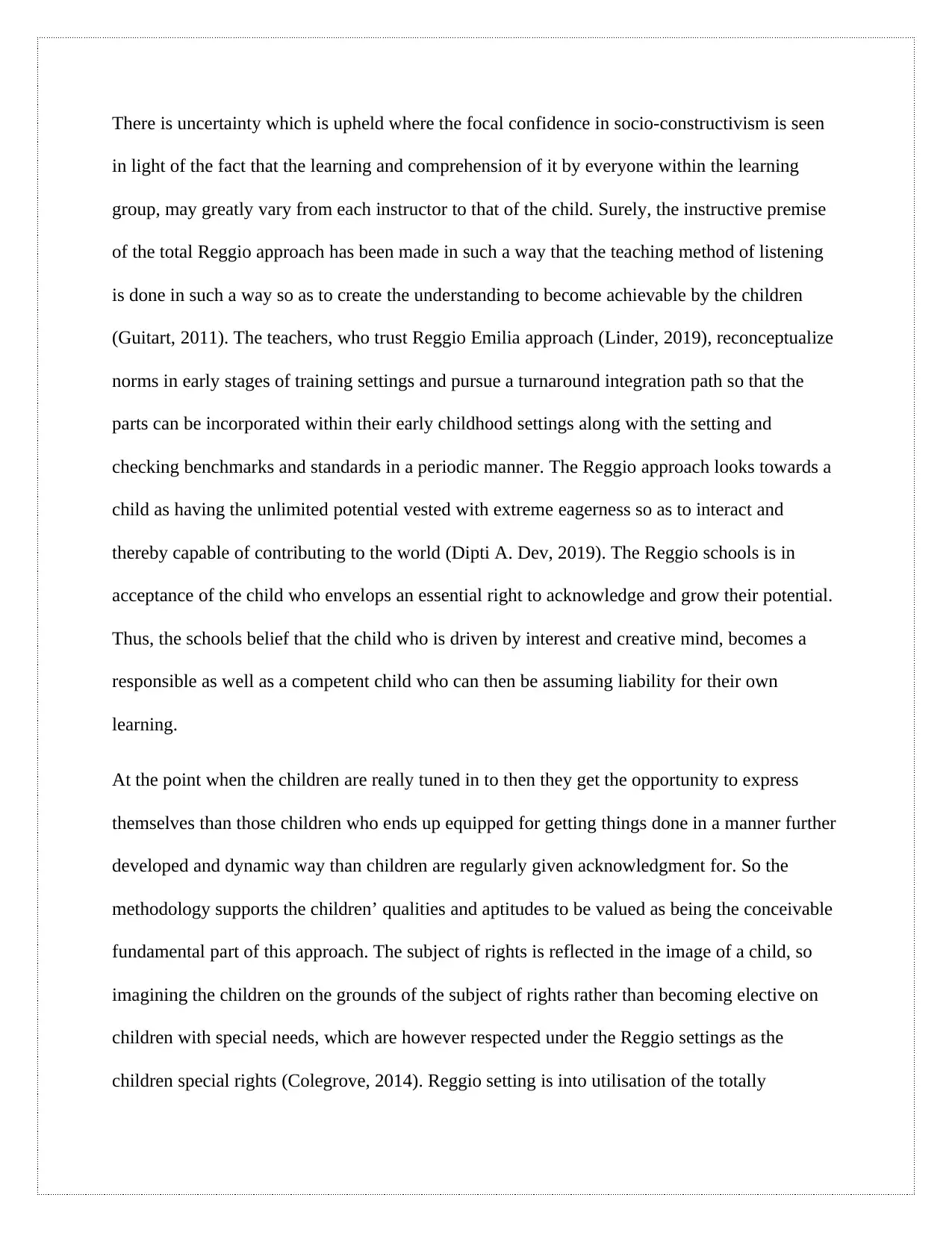
There is uncertainty which is upheld where the focal confidence in socio-constructivism is seen
in light of the fact that the learning and comprehension of it by everyone within the learning
group, may greatly vary from each instructor to that of the child. Surely, the instructive premise
of the total Reggio approach has been made in such a way that the teaching method of listening
is done in such a way so as to create the understanding to become achievable by the children
(Guitart, 2011). The teachers, who trust Reggio Emilia approach (Linder, 2019), reconceptualize
norms in early stages of training settings and pursue a turnaround integration path so that the
parts can be incorporated within their early childhood settings along with the setting and
checking benchmarks and standards in a periodic manner. The Reggio approach looks towards a
child as having the unlimited potential vested with extreme eagerness so as to interact and
thereby capable of contributing to the world (Dipti A. Dev, 2019). The Reggio schools is in
acceptance of the child who envelops an essential right to acknowledge and grow their potential.
Thus, the schools belief that the child who is driven by interest and creative mind, becomes a
responsible as well as a competent child who can then be assuming liability for their own
learning.
At the point when the children are really tuned in to then they get the opportunity to express
themselves than those children who ends up equipped for getting things done in a manner further
developed and dynamic way than children are regularly given acknowledgment for. So the
methodology supports the children’ qualities and aptitudes to be valued as being the conceivable
fundamental part of this approach. The subject of rights is reflected in the image of a child, so
imagining the children on the grounds of the subject of rights rather than becoming elective on
children with special needs, which are however respected under the Reggio settings as the
children special rights (Colegrove, 2014). Reggio setting is into utilisation of the totally
in light of the fact that the learning and comprehension of it by everyone within the learning
group, may greatly vary from each instructor to that of the child. Surely, the instructive premise
of the total Reggio approach has been made in such a way that the teaching method of listening
is done in such a way so as to create the understanding to become achievable by the children
(Guitart, 2011). The teachers, who trust Reggio Emilia approach (Linder, 2019), reconceptualize
norms in early stages of training settings and pursue a turnaround integration path so that the
parts can be incorporated within their early childhood settings along with the setting and
checking benchmarks and standards in a periodic manner. The Reggio approach looks towards a
child as having the unlimited potential vested with extreme eagerness so as to interact and
thereby capable of contributing to the world (Dipti A. Dev, 2019). The Reggio schools is in
acceptance of the child who envelops an essential right to acknowledge and grow their potential.
Thus, the schools belief that the child who is driven by interest and creative mind, becomes a
responsible as well as a competent child who can then be assuming liability for their own
learning.
At the point when the children are really tuned in to then they get the opportunity to express
themselves than those children who ends up equipped for getting things done in a manner further
developed and dynamic way than children are regularly given acknowledgment for. So the
methodology supports the children’ qualities and aptitudes to be valued as being the conceivable
fundamental part of this approach. The subject of rights is reflected in the image of a child, so
imagining the children on the grounds of the subject of rights rather than becoming elective on
children with special needs, which are however respected under the Reggio settings as the
children special rights (Colegrove, 2014). Reggio setting is into utilisation of the totally
⊘ This is a preview!⊘
Do you want full access?
Subscribe today to unlock all pages.

Trusted by 1+ million students worldwide
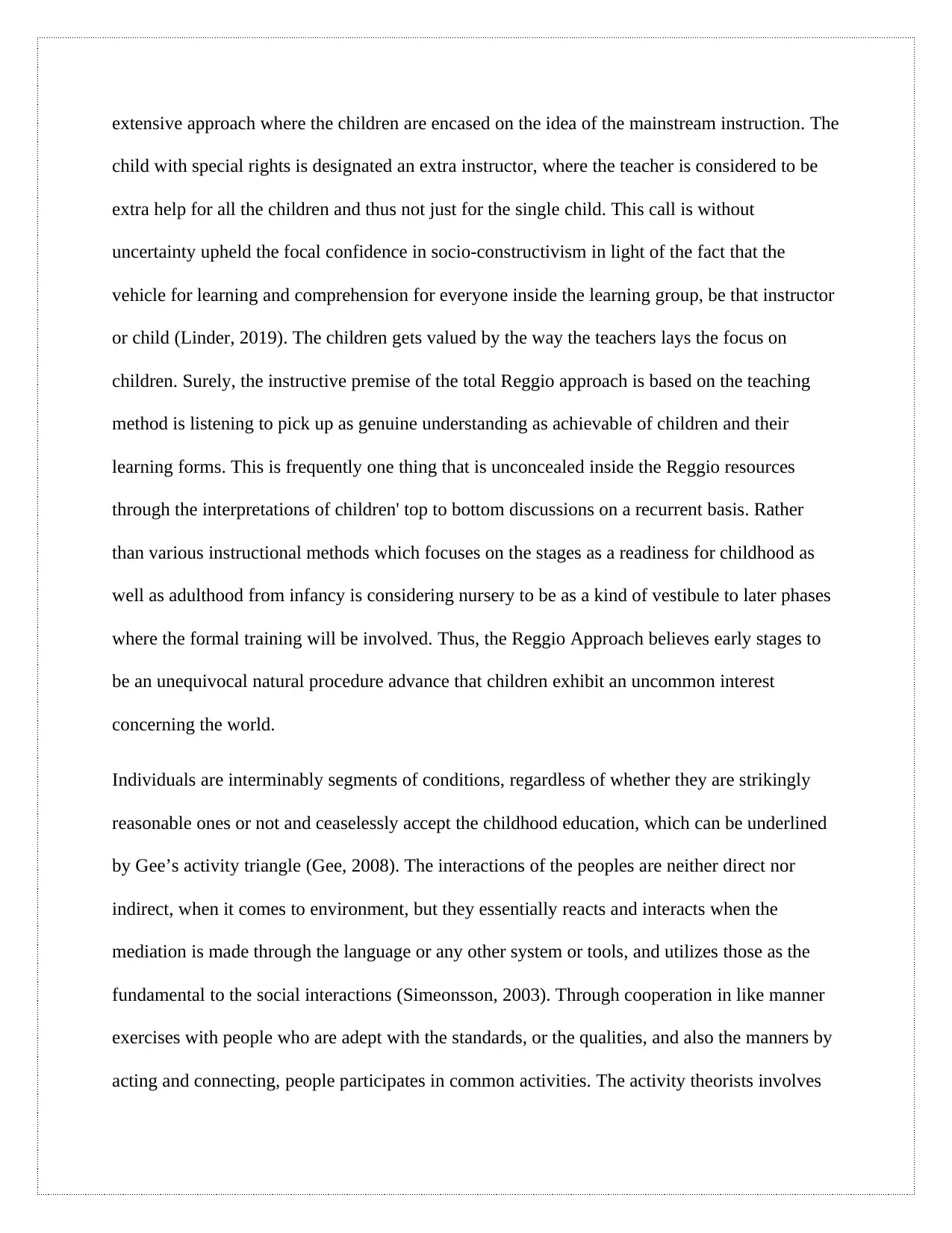
extensive approach where the children are encased on the idea of the mainstream instruction. The
child with special rights is designated an extra instructor, where the teacher is considered to be
extra help for all the children and thus not just for the single child. This call is without
uncertainty upheld the focal confidence in socio-constructivism in light of the fact that the
vehicle for learning and comprehension for everyone inside the learning group, be that instructor
or child (Linder, 2019). The children gets valued by the way the teachers lays the focus on
children. Surely, the instructive premise of the total Reggio approach is based on the teaching
method is listening to pick up as genuine understanding as achievable of children and their
learning forms. This is frequently one thing that is unconcealed inside the Reggio resources
through the interpretations of children' top to bottom discussions on a recurrent basis. Rather
than various instructional methods which focuses on the stages as a readiness for childhood as
well as adulthood from infancy is considering nursery to be as a kind of vestibule to later phases
where the formal training will be involved. Thus, the Reggio Approach believes early stages to
be an unequivocal natural procedure advance that children exhibit an uncommon interest
concerning the world.
Individuals are interminably segments of conditions, regardless of whether they are strikingly
reasonable ones or not and ceaselessly accept the childhood education, which can be underlined
by Gee’s activity triangle (Gee, 2008). The interactions of the peoples are neither direct nor
indirect, when it comes to environment, but they essentially reacts and interacts when the
mediation is made through the language or any other system or tools, and utilizes those as the
fundamental to the social interactions (Simeonsson, 2003). Through cooperation in like manner
exercises with people who are adept with the standards, or the qualities, and also the manners by
acting and connecting, people participates in common activities. The activity theorists involves
child with special rights is designated an extra instructor, where the teacher is considered to be
extra help for all the children and thus not just for the single child. This call is without
uncertainty upheld the focal confidence in socio-constructivism in light of the fact that the
vehicle for learning and comprehension for everyone inside the learning group, be that instructor
or child (Linder, 2019). The children gets valued by the way the teachers lays the focus on
children. Surely, the instructive premise of the total Reggio approach is based on the teaching
method is listening to pick up as genuine understanding as achievable of children and their
learning forms. This is frequently one thing that is unconcealed inside the Reggio resources
through the interpretations of children' top to bottom discussions on a recurrent basis. Rather
than various instructional methods which focuses on the stages as a readiness for childhood as
well as adulthood from infancy is considering nursery to be as a kind of vestibule to later phases
where the formal training will be involved. Thus, the Reggio Approach believes early stages to
be an unequivocal natural procedure advance that children exhibit an uncommon interest
concerning the world.
Individuals are interminably segments of conditions, regardless of whether they are strikingly
reasonable ones or not and ceaselessly accept the childhood education, which can be underlined
by Gee’s activity triangle (Gee, 2008). The interactions of the peoples are neither direct nor
indirect, when it comes to environment, but they essentially reacts and interacts when the
mediation is made through the language or any other system or tools, and utilizes those as the
fundamental to the social interactions (Simeonsson, 2003). Through cooperation in like manner
exercises with people who are adept with the standards, or the qualities, and also the manners by
acting and connecting, people participates in common activities. The activity theorists involves
Paraphrase This Document
Need a fresh take? Get an instant paraphrase of this document with our AI Paraphraser
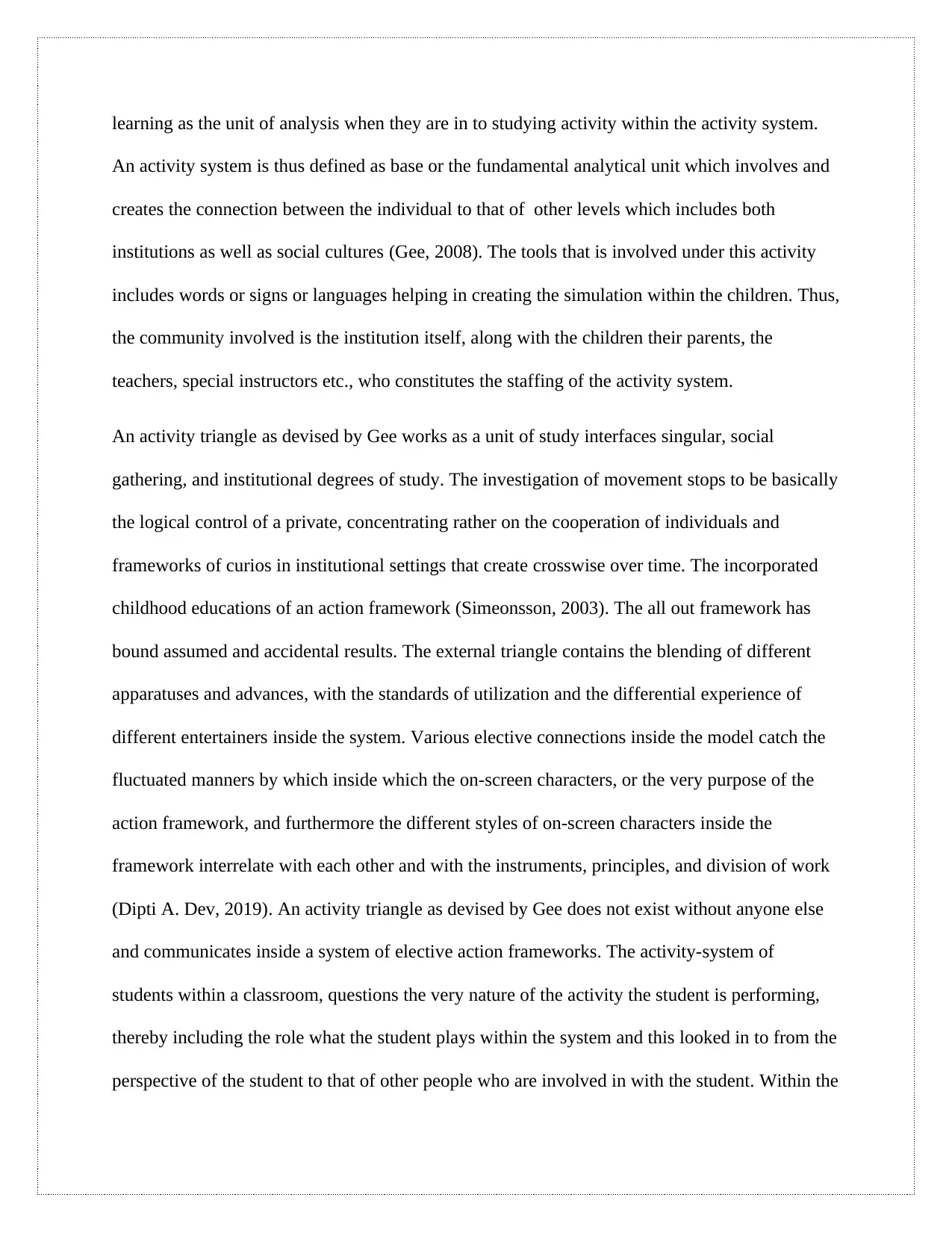
learning as the unit of analysis when they are in to studying activity within the activity system.
An activity system is thus defined as base or the fundamental analytical unit which involves and
creates the connection between the individual to that of other levels which includes both
institutions as well as social cultures (Gee, 2008). The tools that is involved under this activity
includes words or signs or languages helping in creating the simulation within the children. Thus,
the community involved is the institution itself, along with the children their parents, the
teachers, special instructors etc., who constitutes the staffing of the activity system.
An activity triangle as devised by Gee works as a unit of study interfaces singular, social
gathering, and institutional degrees of study. The investigation of movement stops to be basically
the logical control of a private, concentrating rather on the cooperation of individuals and
frameworks of curios in institutional settings that create crosswise over time. The incorporated
childhood educations of an action framework (Simeonsson, 2003). The all out framework has
bound assumed and accidental results. The external triangle contains the blending of different
apparatuses and advances, with the standards of utilization and the differential experience of
different entertainers inside the system. Various elective connections inside the model catch the
fluctuated manners by which inside which the on-screen characters, or the very purpose of the
action framework, and furthermore the different styles of on-screen characters inside the
framework interrelate with each other and with the instruments, principles, and division of work
(Dipti A. Dev, 2019). An activity triangle as devised by Gee does not exist without anyone else
and communicates inside a system of elective action frameworks. The activity-system of
students within a classroom, questions the very nature of the activity the student is performing,
thereby including the role what the student plays within the system and this looked in to from the
perspective of the student to that of other people who are involved in with the student. Within the
An activity system is thus defined as base or the fundamental analytical unit which involves and
creates the connection between the individual to that of other levels which includes both
institutions as well as social cultures (Gee, 2008). The tools that is involved under this activity
includes words or signs or languages helping in creating the simulation within the children. Thus,
the community involved is the institution itself, along with the children their parents, the
teachers, special instructors etc., who constitutes the staffing of the activity system.
An activity triangle as devised by Gee works as a unit of study interfaces singular, social
gathering, and institutional degrees of study. The investigation of movement stops to be basically
the logical control of a private, concentrating rather on the cooperation of individuals and
frameworks of curios in institutional settings that create crosswise over time. The incorporated
childhood educations of an action framework (Simeonsson, 2003). The all out framework has
bound assumed and accidental results. The external triangle contains the blending of different
apparatuses and advances, with the standards of utilization and the differential experience of
different entertainers inside the system. Various elective connections inside the model catch the
fluctuated manners by which inside which the on-screen characters, or the very purpose of the
action framework, and furthermore the different styles of on-screen characters inside the
framework interrelate with each other and with the instruments, principles, and division of work
(Dipti A. Dev, 2019). An activity triangle as devised by Gee does not exist without anyone else
and communicates inside a system of elective action frameworks. The activity-system of
students within a classroom, questions the very nature of the activity the student is performing,
thereby including the role what the student plays within the system and this looked in to from the
perspective of the student to that of other people who are involved in with the student. Within the

classroom framework (Gee, 2008), the object that is the goal of the students’ work is that of
learning, so the outcome will include opportunities as well as learning.
Children have the potential of making their work without any bounds, provided that they are
handed with the material and resources. Primarily the educators or the role of the teachers
involves the recognition of the child thereby composing and indicating them in a way that is
valuable as well as seen as being attractive from the child’s perspective. Allowing the children
with the selection of their choice of material will help them become more encouraged and in so
doing they will get more involved and attentive in what they are doing. However, it is also not
safer to allow the child to pick things of their choice, thus demanding the discerning choices of
the teachers involved. Children getting involved through learning needs the opportunity of
continuation, that is in other words they can continue learning till the time they need, so again
the teachers must be finding the ways to create space for them rather than telling to go home, in a
reasonable manner. Following the Reggio approach might prove to be difficult since that
involves direct learning activities. On the other hand, the Pasifika early community education
need a comprehensive overview, since the perception of the languages combined with the
indicators of quality involves qualified teachers under the Pasifika system of setting. The basic
need is to identify the stages which are involved in the Pasifika setting, so that collaboration can
be made possible on a cross sector basis. Thus, both the early community setting as discussed in
this essay have been discussed while prioritizing the early childhood community under those
setting with the discussion of activity following the Gee’s Activity triangle, based on the
responsibilities which are shared amongst different actors of the community.
learning, so the outcome will include opportunities as well as learning.
Children have the potential of making their work without any bounds, provided that they are
handed with the material and resources. Primarily the educators or the role of the teachers
involves the recognition of the child thereby composing and indicating them in a way that is
valuable as well as seen as being attractive from the child’s perspective. Allowing the children
with the selection of their choice of material will help them become more encouraged and in so
doing they will get more involved and attentive in what they are doing. However, it is also not
safer to allow the child to pick things of their choice, thus demanding the discerning choices of
the teachers involved. Children getting involved through learning needs the opportunity of
continuation, that is in other words they can continue learning till the time they need, so again
the teachers must be finding the ways to create space for them rather than telling to go home, in a
reasonable manner. Following the Reggio approach might prove to be difficult since that
involves direct learning activities. On the other hand, the Pasifika early community education
need a comprehensive overview, since the perception of the languages combined with the
indicators of quality involves qualified teachers under the Pasifika system of setting. The basic
need is to identify the stages which are involved in the Pasifika setting, so that collaboration can
be made possible on a cross sector basis. Thus, both the early community setting as discussed in
this essay have been discussed while prioritizing the early childhood community under those
setting with the discussion of activity following the Gee’s Activity triangle, based on the
responsibilities which are shared amongst different actors of the community.
⊘ This is a preview!⊘
Do you want full access?
Subscribe today to unlock all pages.

Trusted by 1+ million students worldwide
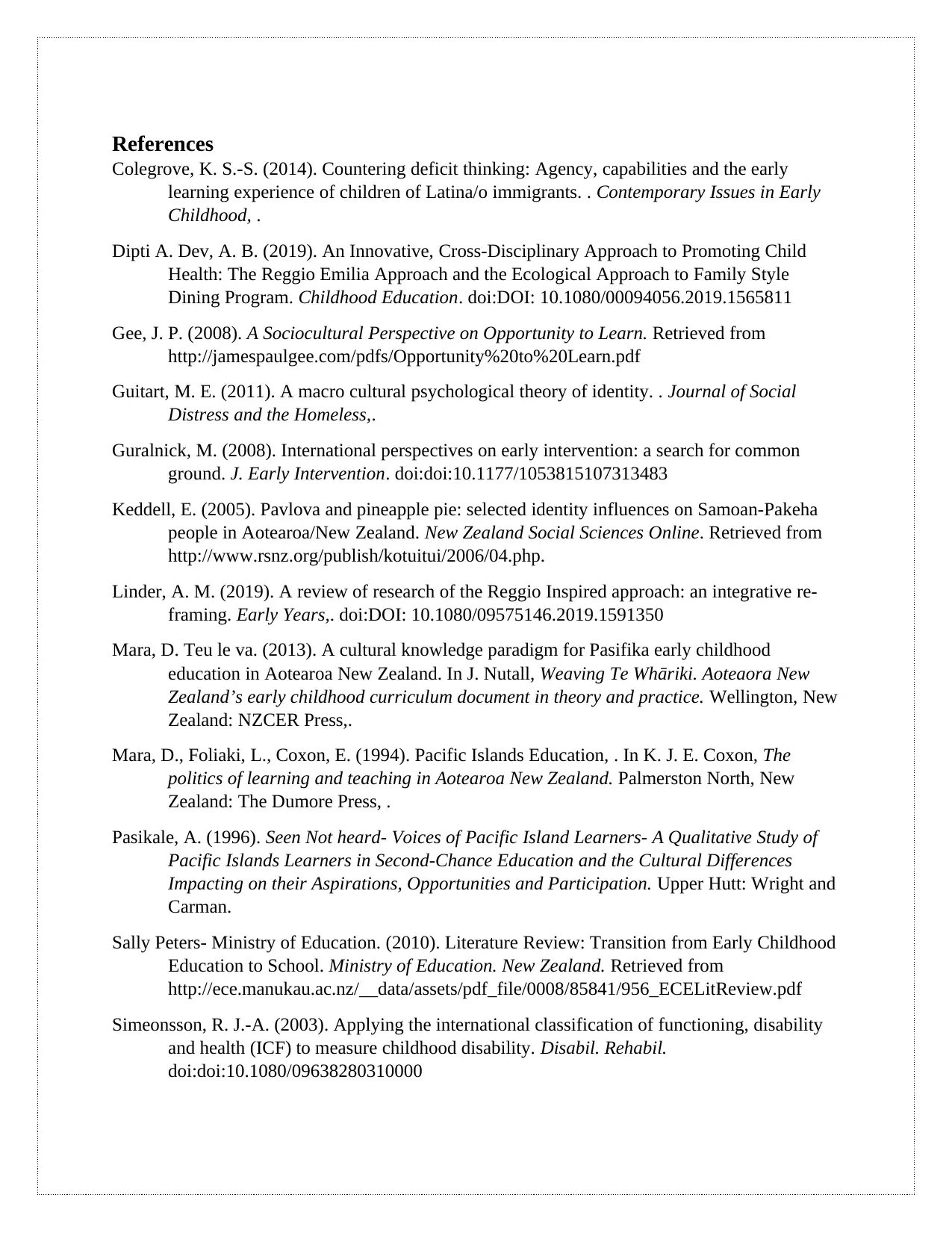
References
Colegrove, K. S.-S. (2014). Countering deficit thinking: Agency, capabilities and the early
learning experience of children of Latina/o immigrants. . Contemporary Issues in Early
Childhood, .
Dipti A. Dev, A. B. (2019). An Innovative, Cross-Disciplinary Approach to Promoting Child
Health: The Reggio Emilia Approach and the Ecological Approach to Family Style
Dining Program. Childhood Education. doi:DOI: 10.1080/00094056.2019.1565811
Gee, J. P. (2008). A Sociocultural Perspective on Opportunity to Learn. Retrieved from
http://jamespaulgee.com/pdfs/Opportunity%20to%20Learn.pdf
Guitart, M. E. (2011). A macro cultural psychological theory of identity. . Journal of Social
Distress and the Homeless,.
Guralnick, M. (2008). International perspectives on early intervention: a search for common
ground. J. Early Intervention. doi:doi:10.1177/1053815107313483
Keddell, E. (2005). Pavlova and pineapple pie: selected identity influences on Samoan-Pakeha
people in Aotearoa/New Zealand. New Zealand Social Sciences Online. Retrieved from
http://www.rsnz.org/publish/kotuitui/2006/04.php.
Linder, A. M. (2019). A review of research of the Reggio Inspired approach: an integrative re-
framing. Early Years,. doi:DOI: 10.1080/09575146.2019.1591350
Mara, D. Teu le va. (2013). A cultural knowledge paradigm for Pasifika early childhood
education in Aotearoa New Zealand. In J. Nutall, Weaving Te Whāriki. Aoteaora New
Zealand’s early childhood curriculum document in theory and practice. Wellington, New
Zealand: NZCER Press,.
Mara, D., Foliaki, L., Coxon, E. (1994). Pacific Islands Education, . In K. J. E. Coxon, The
politics of learning and teaching in Aotearoa New Zealand. Palmerston North, New
Zealand: The Dumore Press, .
Pasikale, A. (1996). Seen Not heard- Voices of Pacific Island Learners- A Qualitative Study of
Pacific Islands Learners in Second-Chance Education and the Cultural Differences
Impacting on their Aspirations, Opportunities and Participation. Upper Hutt: Wright and
Carman.
Sally Peters- Ministry of Education. (2010). Literature Review: Transition from Early Childhood
Education to School. Ministry of Education. New Zealand. Retrieved from
http://ece.manukau.ac.nz/__data/assets/pdf_file/0008/85841/956_ECELitReview.pdf
Simeonsson, R. J.-A. (2003). Applying the international classification of functioning, disability
and health (ICF) to measure childhood disability. Disabil. Rehabil.
doi:doi:10.1080/09638280310000
Colegrove, K. S.-S. (2014). Countering deficit thinking: Agency, capabilities and the early
learning experience of children of Latina/o immigrants. . Contemporary Issues in Early
Childhood, .
Dipti A. Dev, A. B. (2019). An Innovative, Cross-Disciplinary Approach to Promoting Child
Health: The Reggio Emilia Approach and the Ecological Approach to Family Style
Dining Program. Childhood Education. doi:DOI: 10.1080/00094056.2019.1565811
Gee, J. P. (2008). A Sociocultural Perspective on Opportunity to Learn. Retrieved from
http://jamespaulgee.com/pdfs/Opportunity%20to%20Learn.pdf
Guitart, M. E. (2011). A macro cultural psychological theory of identity. . Journal of Social
Distress and the Homeless,.
Guralnick, M. (2008). International perspectives on early intervention: a search for common
ground. J. Early Intervention. doi:doi:10.1177/1053815107313483
Keddell, E. (2005). Pavlova and pineapple pie: selected identity influences on Samoan-Pakeha
people in Aotearoa/New Zealand. New Zealand Social Sciences Online. Retrieved from
http://www.rsnz.org/publish/kotuitui/2006/04.php.
Linder, A. M. (2019). A review of research of the Reggio Inspired approach: an integrative re-
framing. Early Years,. doi:DOI: 10.1080/09575146.2019.1591350
Mara, D. Teu le va. (2013). A cultural knowledge paradigm for Pasifika early childhood
education in Aotearoa New Zealand. In J. Nutall, Weaving Te Whāriki. Aoteaora New
Zealand’s early childhood curriculum document in theory and practice. Wellington, New
Zealand: NZCER Press,.
Mara, D., Foliaki, L., Coxon, E. (1994). Pacific Islands Education, . In K. J. E. Coxon, The
politics of learning and teaching in Aotearoa New Zealand. Palmerston North, New
Zealand: The Dumore Press, .
Pasikale, A. (1996). Seen Not heard- Voices of Pacific Island Learners- A Qualitative Study of
Pacific Islands Learners in Second-Chance Education and the Cultural Differences
Impacting on their Aspirations, Opportunities and Participation. Upper Hutt: Wright and
Carman.
Sally Peters- Ministry of Education. (2010). Literature Review: Transition from Early Childhood
Education to School. Ministry of Education. New Zealand. Retrieved from
http://ece.manukau.ac.nz/__data/assets/pdf_file/0008/85841/956_ECELitReview.pdf
Simeonsson, R. J.-A. (2003). Applying the international classification of functioning, disability
and health (ICF) to measure childhood disability. Disabil. Rehabil.
doi:doi:10.1080/09638280310000
Paraphrase This Document
Need a fresh take? Get an instant paraphrase of this document with our AI Paraphraser
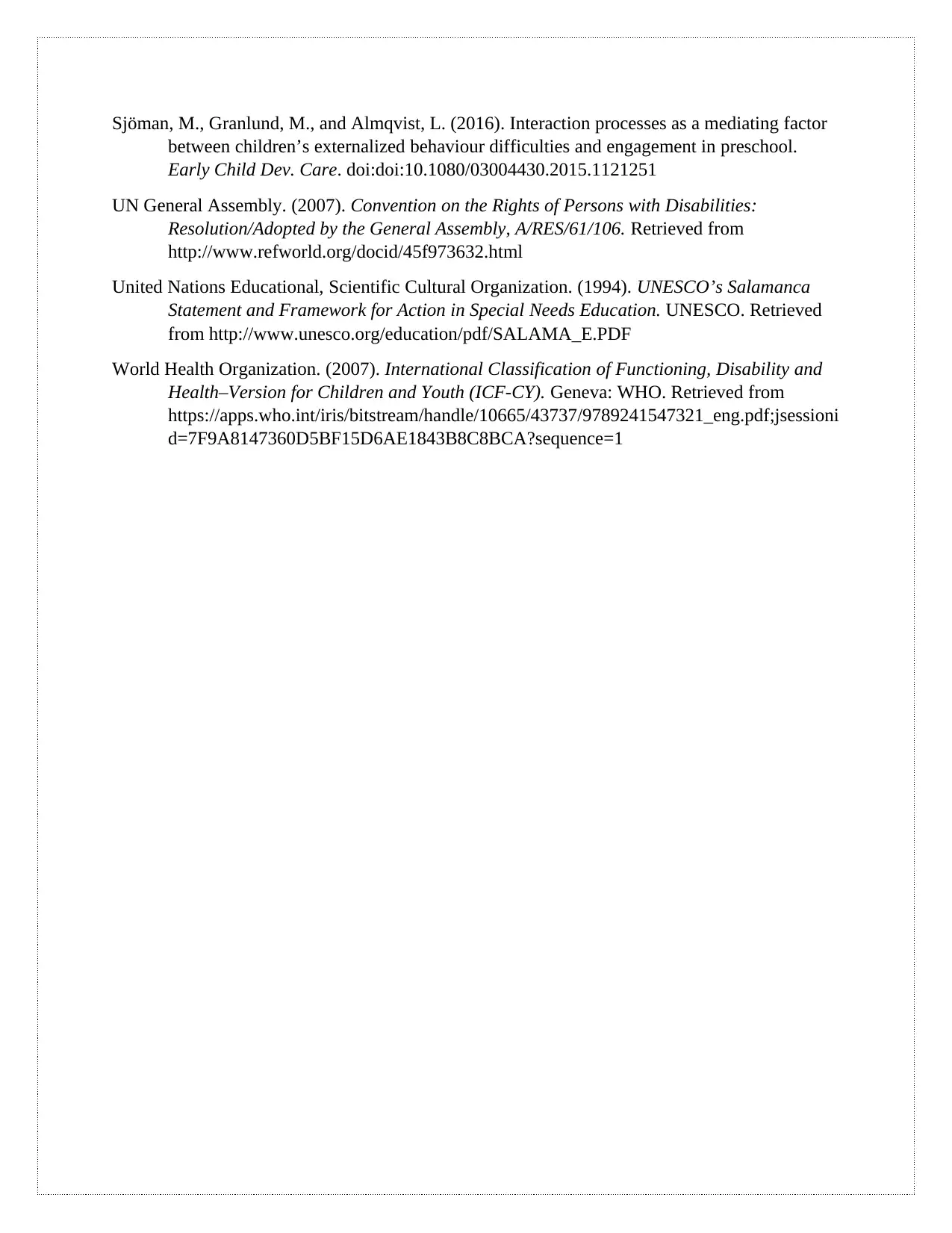
Sjöman, M., Granlund, M., and Almqvist, L. (2016). Interaction processes as a mediating factor
between children’s externalized behaviour difficulties and engagement in preschool.
Early Child Dev. Care. doi:doi:10.1080/03004430.2015.1121251
UN General Assembly. (2007). Convention on the Rights of Persons with Disabilities:
Resolution/Adopted by the General Assembly, A/RES/61/106. Retrieved from
http://www.refworld.org/docid/45f973632.html
United Nations Educational, Scientific Cultural Organization. (1994). UNESCO’s Salamanca
Statement and Framework for Action in Special Needs Education. UNESCO. Retrieved
from http://www.unesco.org/education/pdf/SALAMA_E.PDF
World Health Organization. (2007). International Classification of Functioning, Disability and
Health–Version for Children and Youth (ICF-CY). Geneva: WHO. Retrieved from
https://apps.who.int/iris/bitstream/handle/10665/43737/9789241547321_eng.pdf;jsessioni
d=7F9A8147360D5BF15D6AE1843B8C8BCA?sequence=1
between children’s externalized behaviour difficulties and engagement in preschool.
Early Child Dev. Care. doi:doi:10.1080/03004430.2015.1121251
UN General Assembly. (2007). Convention on the Rights of Persons with Disabilities:
Resolution/Adopted by the General Assembly, A/RES/61/106. Retrieved from
http://www.refworld.org/docid/45f973632.html
United Nations Educational, Scientific Cultural Organization. (1994). UNESCO’s Salamanca
Statement and Framework for Action in Special Needs Education. UNESCO. Retrieved
from http://www.unesco.org/education/pdf/SALAMA_E.PDF
World Health Organization. (2007). International Classification of Functioning, Disability and
Health–Version for Children and Youth (ICF-CY). Geneva: WHO. Retrieved from
https://apps.who.int/iris/bitstream/handle/10665/43737/9789241547321_eng.pdf;jsessioni
d=7F9A8147360D5BF15D6AE1843B8C8BCA?sequence=1
1 out of 11
Your All-in-One AI-Powered Toolkit for Academic Success.
+13062052269
info@desklib.com
Available 24*7 on WhatsApp / Email
![[object Object]](/_next/static/media/star-bottom.7253800d.svg)
Unlock your academic potential
Copyright © 2020–2025 A2Z Services. All Rights Reserved. Developed and managed by ZUCOL.